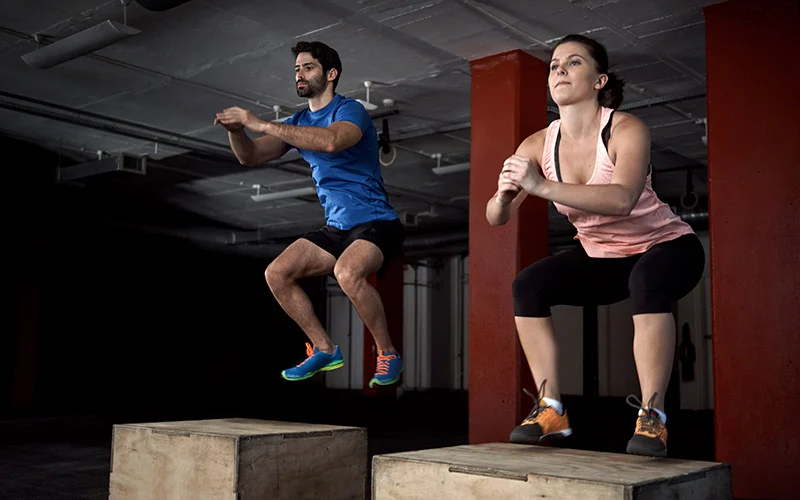One of the most commonly asked questions about plyometrics is whether it’s safe to perform a training session after leg day due to the intensity of the exercise.
Plyometrics are a great way to add increased intensity to your workout routine and to enhance performance and strength-building potential. However, it can also be very taxing on the body, so it’s vital to ensure you’re training safely.
So, keeping all of this in mind, is it safe to do plyometrics after leg day, or is it something that should be avoided?
The quick answer is you can perform plyometrics after leg day, provided your body is ready and that you train safely. However, if you’re using plyometrics to enhance performance, evidence would suggest you could see a greater benefit if you perform it before or even during strength training and other sports.
In this article, we’ll explore the pros and cons of performing plyometrics before and after leg day and how you can safely incorporate it into a strength training session to boost performance.

Should You Do Plyometrics Before or After Leg Day?
Plyometrics is a pretty niche form of exercise, and people who perform it regularly generally use it to increase performance in other kinds of sports. It’s especially helpful for those who want to jump higher (such as basketballers) or kick harder (such as footballers).
Juggling various workouts can get a little complicated and time-consuming, deciding when it’s best to perform plyometrics around leg day can be a particular problem because most plyometrics exercises are leg focused, and a session can be a complete workout in itself.
There are no set rules around when you should perform plyometrics, but there are some important things to consider when you’re fitting it around leg day and other training or sports.
- You need to consider whether your body is ready for plyometrics and how it will impact a workout session you have planned for the following day. Plyometrics is a high-intensity exercise that can put a lot of pressure on your muscles and joints, so you must ensure your body is prepared for it. If you’re experiencing pain from a plyometrics session you did the day before, taking a rest day is a good idea to reduce the risk of potential injury.
- You will need to consider the type of plyometric exercises you’re performing. Some exercises are more intense than others and can put more strain on the body, especially the joints. If you have a big session planned the following day, you might want to be more selective about the kind of moves you choose.
To help you make a judgment call on whether it’s best to perform plyometrics before or after leg day and other strength training or sports, let’s look at each method’s pros and cons.
Pros and Cons of Performing Plyometrics After Leg Day
Performing plyometrics after leg day is doable, provided your body is ready, and you’re not experiencing any pain. Here are the benefits you can expect if this is the route you choose to go down:
Plyometrics After Leg Day: Pros
- Plyometrics is great for strength building and helps increase the potential gains you can make using body weight alone. If you’ve done leg day the day before and you’re still feeling good, plyometrics can help build on the gains you’ve already made.
- If you find leg day boring and a chore, moving onto a plyometrics session the following day means you can perform a more spontaneous and enjoyable workout. This can help make your overall exercise routine more fun and increase the chances of maintaining a regular training habit.
- You can increase flexibility and mobility using plyometrics, which helps expand the range of exercises you can do during strength training and sports.
Plyometrics After Leg Day: Cons
- If you’ve had an intense leg day the day before and you’re experiencing pain or injury, doing plyometrics the day after could make the situation worse and increase the risk of greater injury.
- Plyometrics is pretty intense on the legs, so if you do it the following day, you’re effectively doing two leg days without rest.
- If your legs are still stiff from the day before, it may limit your body’s potential to do certain plyometric exercises, decreasing the potential benefits you can get from a training session.

Pros and Cons of Performing Plyometrics Before Leg Day
Some experts suggest that there could be greater advantages to performing plyometrics before leg day or other strength training; however, there are pros and cons with this method too:
Plyometrics Before Leg Day: Pros
- By regularly doing plyometrics before leg day or other strength training, you can improve your performance and increase your range of movement. Plyometrics helps improve flexibility, mobility, and strength, which all help to make you physically stronger and more agile.
- A combination of plyometrics and strength training can greatly improve performance if you do other kinds of sports that require good leg strength and agility. Examples of this are; basketball, where you need to jump high, or soccer, where you need to kick hard.
- Plyometrics helps stretch and activate the muscles, which can help make leg day easier if you’re performing it the day after.
Plyometrics Before Leg Day: Cons
- If you do a particularly heavy plyometrics session before leg day, you might feel too sore or stiff to do a leg session the following day.
- Some experts recommend taking a rest day after a plyometrics session, especially if you’ve trained hard. Resting between workouts helps avoid the risk of injury and reduces the chances of sore muscles.
- If you’re tired following a plyometrics workout from the day before, you might not perform as well on leg day as you would usually.
How to Safely Perform Plyometrics After Leg Day
If you decide to go down the route of regularly performing plyometrics before leg day, there are some things that you can do to limit the potential risk of injury as well as muscle pain the following day, including:
- Warming up and down effectively before and after a plyometrics session, paying particular attention to the muscle groups and joints you’ll use most during the workout.
- If you’re fairly new to plyometrics, don’t try to do too much too soon, especially if you’re doing other forms of training between workouts.
- If you’re feeling pain from the day before beyond normal muscle fatigue, take a rest day and seek medical advice if you suspect an injury. Performing plyometrics with an injury can make things much worse.
- Try to incorporate a range of exercises into your plyometrics session to focus on various muscle groups rather than one or two particular areas.
The key is to listen to your body. If it doesn’t feel right, take a rest day and evaluate or do something less intense, such as a lower-intensity cardio workout.
Do You Even Need Leg Day If You Do Plyometrics?
Because plyometrics is a leg workout in itself, the question remains, do you even need to do leg day if you’ve done a complete workout the day before?
The answer is it really depends on your goals and what you’re looking to gain from your weekly exercise routine.
For example, if you’re looking for a general increase in strength and fitness, plyometrics alone might be enough to see some excellent results. However, leg day is more important if you need to take things to the next level when it comes to strength building using weights and exercise machines.
Provided you perform a range of exercises, plyometrics will give you a full body workout that goes further than other kinds of body weight exercise. So how you incorporate it into your weekly routine is entirely up to you.

Incorporating Plyometrics Into Strength Training
Many professionals have reported benefits from incorporating plyometrics into leg day and other strength training rather than performing separate sessions.
The best way to add plyometrics into strength training is to start slowly and incorporate a few exercises at a time, using the following routine:
- Warm-Up/Stretches
- Plyometrics (choose from a few moves which are lower in intensity if you’ve not used them during strength training before)
- Strength Training
- Warm Down/Stretches
If this is something you’re considering, it’s a good idea to make sure you know the pros and cons of going down this route.
Plyometrics During Strength Training: Pros
- The main benefit of performing plyometrics during a strength training workout is the boost it can give to your performance by starting with an activity that stretches and warms up the muscles for optimum results.
- Adding plyometrics exercises into strength training saves time and allows you to rest between workouts.
- By incorporating plyometrics into strength training, you should still see the same results in the long term as you would doing them on separate days and the same benefits when it comes to enhancing strength, mobility, and flexibility.
Plyometrics During Strength Training: Cons
- Incorporating plyometrics and strength training together can make a workout much tougher and is best for those who already have a degree of strength and a higher fitness level.
- Performing more intense moves during training can increase the risk of injury and put more pressure on joints, particularly the ankles, hips, and knees. Because of this, plyometrics is not recommended for those with existing joint problems.
- An intense workout can lead to more muscle pain and stiffness the following day, which can impact other exercise and everyday activities.
How Often Should You Perform Plyometrics?
Because plyometrics is considered an intense form of exercise, it’s recommended that you don’t do more than three sessions weekly to reduce the risk of injury and minimize impact on the joints.
For some, one session per week will be enough to improve strength and agility, especially if you’re incorporating other kinds of exercise and sports into your weekly routine.
If you’re looking to do three sessions per week, you might need to reduce the intensity of your workout by choosing exercises that don’t put too much impact on the joints. However, this depends on your ability, strength, and how your body can handle high-impact exercise.
The Importance of Rest Days
When plyometrics are alternated with strength training, this can lead to an intense weekly routine, and it’s important to allow your body to rest in between sessions. The more kinds of training you add to your weekly routine, the less chance you have to allow your body to recover.
This is one of the main reasons why many choose to incorporate plyometrics and strength training together rather than doing them separately.
Combining the two kinds of exercise gives you more opportunity to rest between sessions.

Conclusion
So having covered all possible ways that you can include plyometrics into your weekly workout routine and, most importantly, around leg day, here’s an overview of the main points:
- You can do plyometrics after leg day, provided you consider the risks and your body is ready. However, general opinion suggests you might benefit more if you perform it before or during a strength training session.
- Incorporating plyometrics into leg day helps save time and allows more rest days if you have a busy weekly exercise routine.
- To avoid the risk of injury, you need to avoid training if you’re feeling pain or have an injury and take regular rest days. You also need to make sure that you warm up and down with stretches that focus on the areas you’ll be concentrating on.
- Intense plyometrics sessions should be limited to one to three sessions per week.
Ultimately, when you choose to train using plyometrics is entirely up to you and depends on your experience and ability. Provided you’re aware of the risks, you can train relatively safely and see some amazing benefits as the result of your hard work.
As always, if you’re in any doubt about whether you should do a certain kind of exercise, it’s always a good idea to seek expert advice from a medical professional or qualified personal trainer before you start.

